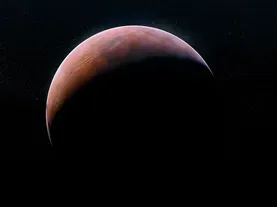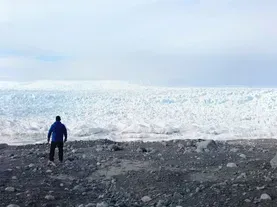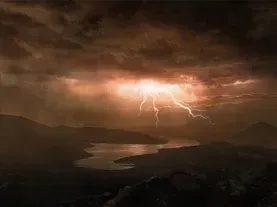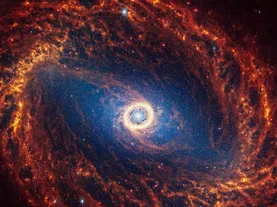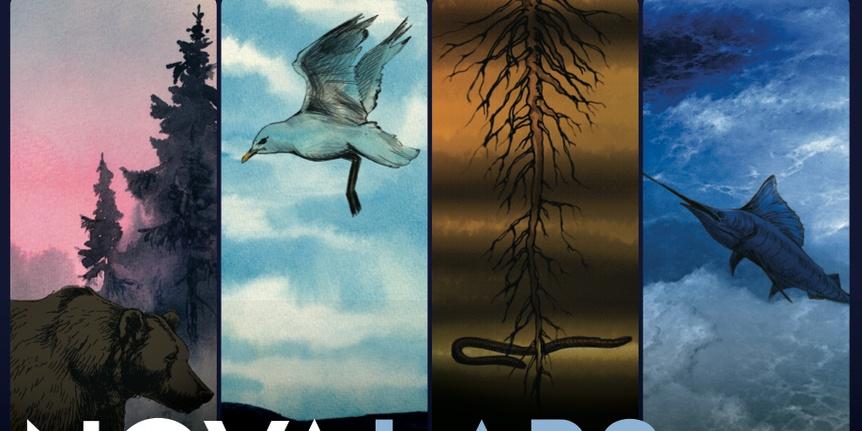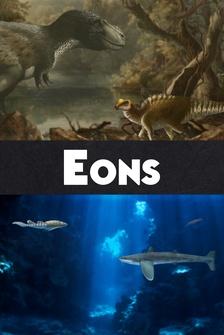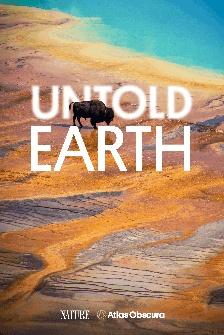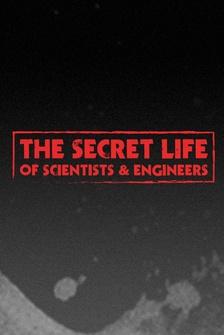NARRATOR: Across the solar system, spectacular storms are raging.
JAMES DOTTIN: What we've learned about weather on other planets has rewritten the rulebook on what we thought was possible.
NARRATOR: From corrosive clouds... GEORGE DRANSFIELD: If you were to go skydiving through the clouds of Venus, there wouldn't be a lot of you left at the end.
NARRATOR: ...to global dust storms.
DAVID GRINSPOON: On Mars, the whole atmosphere basically freaks out, and the storm grows to the point where it engulfs the entire planet.
We don't have anything like that on Earth.
NARRATOR: Storms found in unexpected places... DERRICK PITTS: It's a moon that looks like this!
How do you have these features on the moon of a planet?
NARRATOR: ...and made of bizarre materials.
SHANNON MACKENZIE: Buckets and buckets of rain are falling on the surface, and yet, it's not water raining out of the atmosphere, but liquid methane.
NARRATOR: Extra-terrestrial weather makes exploration challenging.
ABIGAIL FRAEMAN: Seeing the skies get darker and darker and darker, we started to realize that, "Oh, this is actually, this is a really bad one."
NARRATOR: But can teach us so much.
PETER GAO: It opens up the possibilities of, "What is weather?"
NARRATOR: What drives these exotic storms raging across the solar system?
And how do they shape a planet's destiny?
"Solar System: Storm Worlds."
Right now, on "NOVA."
♪ ♪ ♪ ♪ NARRATOR: It's midsummer.
♪ ♪ A storm is brewing.
♪ ♪ It unleashes torrents of rain... ...forming floods that drain into rushing rivers... ♪ ♪ ...and giant lakes.
♪ ♪ This is the only world in our solar system where rainstorms pummel the surface.
♪ ♪ The only world other than Earth.
Here, more than 800 million miles from the sun... ...orbits the largest of Saturn's moons.
In some ways, Titan is more similar to Earth than any other place in the solar system.
But upon closer inspection, you will find that it's actually exceptionally alien.
The surface temperature of Titan is around -300 degrees Fahrenheit.
NARRATOR: Far too cold for liquid water.
DOTTIN: What's fascinating is that the rain that's falling out of the sky on Titan and filling up the lakes is usually found on Earth as a flammable gas.
NARRATOR: Methane.
Titan is a world shaped by alien storms, and it is not alone.
MACKENZIE: It's pretty mind-blowing that as we look elsewhere in the solar system, we see these weather patterns that look very familiar to us, and yet there are also these wild extremes.
♪ ♪ DRANSFIELD: Some of the storms we're seeing are like supersized versions of the storms that we see here on Earth.
♪ ♪ NARRATOR: And the more we explore, the more weird and wonderful weather we're finding.
GRINSPOON: Pretty much every planet with weather has some oddity to it that's surprised us.
NARRATOR: So what creates the wild diversity in weather across the solar system?
GAO: We're so used to dealing with our specific brand of weather.
But there's just so much more out there, if you look at these stormy worlds.
♪ ♪ ♪ ♪ ALEJANDRO SOTO: When I hear the word "weather," I get a memory of when I was a kid, standing out in a field... ♪ ♪ ...when the wind would pick up, the sky would darken a bit, and you knew it was about to rain.
(wind gusting) And yet it would also be the best.
NARRATOR: From towering thunderstorms to howling blizzards to choking dust storms, our atmosphere is a restless place.
But what causes all this chaos?
JEN GUPTA: Earth, like all the planets, is essentially a big ball floating in space being heated by the sun.
It's pretty simple, really.
But because of the shape of a planet, its spherical geometry, it's actually really hard to heat the planet evenly.
For a start, there's always a side of the Earth in darkness, the night side of the planet.
DOTTIN: And some parts, like the Equator, receive more sunlight than others, like the poles, and that creates an energy imbalance.
But because the Earth is surrounded by this atmosphere, this envelope of gas that's free to move around, it can carry the heat from the hot places to the cold in an attempt to equalize this imbalance.
LEIGH FLETCHER: And without that conveyor belt of energy motion, we wouldn't have the incredible diversity of weather that we can see around us today.
♪ ♪ NARRATOR: Wind, rain, and lightning are all side effects as our atmosphere balances hot and cold.
♪ ♪ And what applies here applies elsewhere, too.
CLARA SOUSA-SILVA: In our solar system, wherever there's an atmosphere, there's weather, no matter how different an atmosphere from Earth's.
FRAEMAN: Some are thicker, some are thinner, sometimes they're made of different things.
And all of these combine to give these crazy cool weather systems that are all so different across the solar system.
♪ ♪ NARRATOR: To see this alien weather in action across our vast solar system, we head away from our shared star... ♪ ♪ ...passing a planet so small and close to the sun that it has no atmosphere, to encounter a planet smothered by one.
PITTS: Venus looks so beautiful in the evening sky.
Brilliant, clear, white, just stunningly lovely to see, yet it's such a horribly nasty environment.
NARRATOR: Looking down from orbit, we can't actually see Venus's surface at all.
Instead, all we see are endless, thick, churning clouds that completely conceal the rest of the planet.
♪ ♪ GRINSPOON: Historically, we thought, "Oh, Venus has clouds.
"They're probably made out of water.
It might be sort of nice there."
(laughing): But then, when we started to actually get data from spacecraft, we discovered, no, they're not water.
In fact, they're battery acid.
♪ ♪ SOUSA-SILVA: The clouds on Venus are made up of extremely concentrated sulfuric acid, one of the most corrosive substances we know of.
If you were to go skydiving through the clouds of Venus, there wouldn't be a lot of you left at the end.
NARRATOR: But if we could withstand the acid and took the plunge down through Venus's clouds... ...we'd reach a landscape that is eerily calm... ...but with air pressure more than 90 times greater than at Earth's surface.
GAO: Even though we don't realize it, air has weight.
It's being pulled down by gravity, just like the rest of us.
And so, on Venus, where the atmosphere is so thick and so massive, all that air is being pulled down, and if we're on the bottom of it, then we'll feel all that pressure.
SOUSA-SILVA: If you find yourself on the surface of Venus, you would almost immediately be crushed.
But if somehow you survived and tried to go for a stroll, it would be exhausting.
The atmosphere is so thick, it would be like walking through molasses.
NARRATOR: The surface of Venus is comparable to the bottom of Earth's oceans, but with a key difference.
At about 900 degrees Fahrenheit, this is the hottest planetary surface in the solar system.
And again, Venus's extreme atmosphere is responsible.
SOUSA-SILVA: Carbon dioxide and other molecules are able to absorb and radiate heat, and so, in large enough quantities, they can act like a planetary blanket that traps that heat in a planet.
That's what we call the greenhouse effect.
NARRATOR: And Venus's incredibly dense atmosphere is 96.5% carbon dioxide.
♪ ♪ Even 0.04% CO2 in our atmosphere is enough to initiate a climate crisis in our world right now.
So you can imagine how bad it is on Venus.
NARRATOR: Venus's extreme greenhouse effect means it's even hotter than Mercury.
Which is why what we would find there is so extraordinary.
♪ ♪ What look like snow-capped mountains towering over the scalding surface.
For generations, we could only guess at what lay beneath Venus's clouds.
But, thanks to radar images beamed back by NASA's Magellan orbiter, we now have detailed maps of the planet's surface.
So, here we have an image taken by Magellan, and what we're looking at is actually Maxwell Montes.
Maxwell Montes here is the highest region on Venus.
And what you'll notice is that around this image, the surface looks dark.
But in the center, where Maxwell Montes is, it's much brighter-- it almost looks white.
We weren't expecting to have such radar-bright regions on the highlands, in the mountaintops of Venus.
♪ ♪ GUPTA: When you see those radar images of Maxwell Montes, it's hard not to imagine snow-capped mountains.
♪ ♪ NARRATOR: But given the conditions on Venus, snow as we know it is impossible.
♪ ♪ In places, it's so hot, the ground actually glows, like metal coming out of a forge.
GRINSPOON: On Earth, you can imagine waiting till nighttime to cool off.
That wouldn't work on Venus.
There's no relief at night on Venus from the temperature.
And in fact, if you go from the equator to the pole, it doesn't get any cooler, for the same reason-- that thick atmosphere is very efficient at redistributing the heat.
NARRATOR: It is a world where there is no place for snow to hide.
But there's one way to cool off on Venus, and that's to go up a mountain.
♪ ♪ NARRATOR: A phenomenon that we here on Earth can also relate to.
♪ ♪ PORT: Everyone knows when you go up a mountain, you should always pack a jacket.
And the reason for that is because it's much colder.
But why is it colder?
Well, when you go up a mountain, there's less air, and that means there's less pressure.
♪ ♪ NARRATOR: And as the pressure decreases, so does the temperature.
PORT: So, as we go up in elevation, we cross a threshold where the temperature drops low enough that water can be a solid.
And this is what we call the snow line.
NARRATOR: Venus's snow line suggests something may be freezing up there.
But even its highest peaks are far too hot for that something to be water.
And that points us to substances that solidify at much higher temperatures.
PORT: So, instead of water, it actually could be something like this.
So this is a piece of galena, also known as a lead sulfide.
On Earth, it's present as a solid, as you can see here.
But on Venus, it may only be a solid in the highlands.
NARRATOR: Deep in Venus's lowlands, like valleys, it's hot enough for compounds like lead sulfide to vaporize, drift on the wind, and, as the winds flow up into the mountains of Maxwell Montes... ...the temperature drops just enough for the compounds to freeze out of the air.
At 820 degrees Fahrenheit, Venus's atmosphere may coat its mountaintops not in snow, but in a metallic frost.
PORT: We still don't know for sure if metal frost can explain the bright regions that we're seeing on the mountaintops.
There's still a lot that we don't know about Venus, and that's because we haven't even sent a lander to the surface of Venus since the 1980s.
But it's amazing to think that something like this could be condensing on the mountaintops of Venus.
When we think of the possibility of metallic frost on Venus, it sounds crazy, but that's only crazy for us Earthlings.
If you have a different atmosphere, you get different weather, different phenomena playing out.
♪ ♪ NARRATOR: Leaving this crushing world behind... ...we head out in search of an atmosphere that could almost be Venus's opposite.
To reach it, we bypass our own planet.
Passing two potato-shaped moons orbiting our other next-door neighbor, we encounter an atmosphere more than 10,000 times thinner than Venus's.
With little in the way of cloud cover, we don't need radar to get a look at the Martian surface.
Yet, images sent back by our orbiters suggest rain may have once fallen here.
These pictures show that Mars is covered in features which appear to have been created by flowing water.
DOTTIN: With such a thin atmosphere, it's really difficult to retain heat, and certainly not enough heat to have liquid water on the surface.
NARRATOR: So if Mars was once home to lakes and rivers, it must have had a much thicker atmosphere in the past.
FRAEMAN: In the early 2000s, we'd seen that there were hints that liquid water had once been on the Martian surface from our orbiters, but we didn't have definitive proof from the surface.
So the goal of the Mars Exploration Rover mission was to follow the water.
MAN: T minus five, four, three, two, main engine start, zero, and liftoff of the Delta rocket with Opportunity, a chance to explore and unlock the secrets of our neighboring planet.
FRAEMAN: I was 16 years old when Spirit and Opportunity launched and landed on Mars.
But I had the amazing opportunity through an outreach program to actually go to be at NASA, at the Jet Propulsion Laboratory, when the rovers landed.
MAN: Getting a bounce to signal.
(cheering) FRAEMAN: And I was in the room with the science team when Opportunity landed on Mars, and it was the most amazing experience.
(cheering and applauding) NARRATOR: Two rovers named Spirit and Opportunity were sent to opposite sides of the Red Planet to search for definitive proof that Mars's dry landscape was once a water world.
At first glance, modern Mars doesn't appear to be a very dynamic place.
With an average surface temperature of about -80 degrees Fahrenheit and an atmosphere just one percent as thick as Earth's, it is a freezing desert.
Typically, we think of Mars as this dead world.
But we do see changes on the surface over time.
NARRATOR: Strange, overlapping lines, often dozens of feet wide, can stretch for miles.
Unlike many of Mars's features, these are not relics.
We see them appear and disappear.
What are these bizarre, shape-shifting patterns?
♪ ♪ In January 2004, Spirit and Opportunity began to investigate Mars.
♪ ♪ But their mission wasn't expected to last very long.
GUPTA: Mars is covered in dust.
It gets everywhere, including on the solar panels of Mars rovers.
As the solar panels got dustier and dustier, the power levels that the rover would have would get lower and lower and lower, and eventually, they would just stop working.
NARRATOR: The team hoped the rovers would last at least three months, a feat they surpassed.
But, as the months wore on, the power levels continued to drop.
What was really exciting was, at one point in the mission, as we were seeing the power levels getting lower and lower and lower, all of a sudden, the power levels were back up high again.
♪ ♪ Almost as high as they were when the rovers had landed.
And you can take a look at the before and after pictures, and you can see that it looks like the solar panels have just been wiped clean.
You could call up AAA and send them to Mars with the rag to clean everything off.
They couldn't have done a better job.
NARRATOR: Finally, a clue to what might be happening was spotted by Spirit's Navcam.
♪ ♪ In the mid-afternoon sun... ♪ ♪ ...heating of the Martian surface creates towering vortices, which can grow miles high.
Dust devils.
GUPTA: I imagine it would be absolutely terrifying to be standing on the surface of Mars and see one of these dust devils coming straight at you.
FRAEMAN: You might think that there was this tornado-force wind coming towards the rover, and it might pick the rover up and spin them around and do all sorts of horrible things.
But in reality, the Martian atmosphere is actually very, very thin, and so you can have a dust devil pass over you and, and you would barely even notice it.
But even though a Martian dust devil might not be able to pick you up, it can certainly pick dust up.
NARRATOR: It's thought that as these whirlwinds traveled over the rovers, they sucked dust off the solar panels, like a vacuum.
So a mission expected to last just a few months was extended again, and again, and again.
But the cleaning power of the dust devils doesn't just work on rovers.
(wind roaring) ♪ ♪ As they travel, these huge vortices suck up dust from Mars's surface, exposing the darker bedrock beneath.
Leaving trails so large, we can see them clearly from space.
♪ ♪ There are no Martians creating the lines.
The culprit is the Martian atmosphere.
Dust devils might create the tracks, but something else wipes them away.
♪ ♪ Just like Earth, Mars has a tilt that gives it seasons.
Summer in one hemisphere means winter in the other.
And with no oceans or thick atmosphere to help spread heat around the globe, an extreme temperature difference.
So here, dust helps drive the action.
♪ ♪ As summer arrives in the southern hemisphere, warmer temperatures drive stronger winds, which kick dust up into the air.
The dust absorbs sunlight and heats the air around it... ...further strengthening the winds, which lift even more dust... ...until a storm forms... ...wiping away dust devil trails.
And these storms can combine and grow so large... ...that they engulf the entire planet, sometimes blocking more than 99% of the incoming sunlight from reaching the surface... ...and the solar panels of Mars rovers.
In May 2018, with Opportunity still active on the surface, a storm began to build.
FRAEMAN: It only took a couple of days of seeing the skies get darker and darker and darker before we started to realize that, "Oh, this is actually, this is a really bad one."
Um, and by the end of the week, we knew that this was the worst dust storm that we were ever gonna have to survive.
We knew we were probably gonna lose communication with Oppy.
So we let her go dark and we just waited and waited.
NARRATOR: Mars's low gravity means the dust in the air can remain there for months.
♪ ♪ Eventually, with so little sunlight reaching the Martian surface, the temperature differences which fueled the storm are dampened, cutting off its own energy supply, and the dust finally settles.
But by the end of 2018, even after the Martian skies had cleared, there was no signal from Opportunity.
And with winter looming, it was unlikely the rover's electronics would survive the cold.
♪ ♪ On February 13, 2019, NASA declared its mission complete.
FRAEMAN: I know it sounds weird, 'cause it's a robot... (laughs) ...but it's sort of the same feeling you have when you might lose a loved one who's lived a very full life.
I was a high school student when they landed.
By the time Opportunity's mission ended, I had gone to college, I had gotten a Ph.D., I had done a post-doc, and then I had been hired by NASA to work on this very same Opportunity rover that had inspired me when I was a high school student.
NARRATOR: Sent to Mars to hunt for ancient evidence of water, Opportunity not only succeeded, but exceeded expectations, lasting over 14 years thanks to the Martian weather.
♪ ♪ Despite their differences, Venus and Mars have one thing in common.
Their weather is powered by solar energy.
But beyond the asteroid belt... ...ruled by the dwarf planet Ceres, the sun's influence wanes.
And yet, the next planet we encounter is a storm world... ...on the grandest scale.
PITTS: If you were just arriving at Jupiter in a spacecraft, you would be stunned by what you see.
First of all, there's the size.
You can fit 1,300 planet Earths inside Jupiter.
In fact, you could fit all of the planets in the solar system inside Jupiter and still have room to spare.
NARRATOR: Jupiter is a gas giant on which storms can grow bigger than Earth itself.
Since 2016, NASA's Juno spacecraft has been exploring this gargantuan planet and found its weather is anything but subtle.
(thunder rumbling) Jupiter's thunderstorms can produce lightning bolts ten times more energetic than anything recorded on Earth.
(thunder rumbling, lightning crackling) Most of the flashes lie beneath thick ammonia ice clouds.
But the most powerful storms break free, soaring to the edge of space.
(thunder booming, lightning crackling) The scale of Jupiter's storms may be hard to comprehend.
But Juno found that the frequency of its lightning strikes is remarkably similar to Earth's thunderclouds.
DRANSFIELD: It's odd that lightning is such a common occurrence here on Earth, but it's taken us centuries to really understand how it works.
(thunder claps, lightning crackles) NARRATOR: The substance responsible for our planet's thunderstorms is water.
The way that lightning gets formed is that it relies on collisions between icy particles and watery droplets.
And as the watery droplets are moving upwards and colliding with the icy particles that are falling downwards, they're exchanging charge with each other.
So you get a separation of charge from the top of a cloud to the bottom of the cloud.
And as that separation of charge becomes bigger and bigger and bigger, eventually, the atmosphere can't cope anymore.
PITTS: And when that occurs, now a flow of electricity can happen.
(lightning crackling) NARRATOR: A single bolt of lightning is so powerful, it can heat the surrounding air to temperatures greater than the surface of the sun.
♪ ♪ So how can clouds produce so much energy?
HEIDI BECKER: For all of our history, lightning has been something that humans have feared.
But what's driving it really is the water cycle.
The sun heats the water, it evaporates, becomes water vapor, rises up into the atmosphere, cools, and eventually becomes water droplets in clouds.
And intuitively, as humans, we actually understand what's happening very well.
We wet our hand, and it feels cold because the water is stealing energy from our hand, breaking up the water molecules, turning them into water vapor so that they can rise up into the sky.
NARRATOR: Water evaporation requires energy, whether it's from our body heat or the sun.
As water turns from a liquid to a gas, it stores this energy.
And when it turns back into a liquid, in the form of clouds, it releases this energy back into the atmosphere.
What's kind of incredible to believe is that a, a small little cumulus cloud that you might see floating in the sky, looking so graceful and peaceful, is actually the result of an enormous amount of energy being released.
It's the same as hundreds of tons of TNT.
NARRATOR: And for an average thunderstorm, the energy released is equivalent to a nuclear blast.
It's this huge release of heat that makes thunderclouds so turbulent, causing the countless icy collisions... (thunder rumbling, lightning crackling) ...which power Earth's lightning.
Several missions to Jupiter have detected water in its atmosphere.
But the planet receives just four percent of the sunlight that reaches Earth, too little energy to account for its ferocious lightning storms.
♪ ♪ But looking at the planet in infrared reveals a different source of energy.
Jupiter is radiating heat, almost twice the energy it receives from the sun.
FLETCHER: So, Jupiter itself is slowly cooling, and has been over the entire age of the solar system.
And as it's cooling, the entire gas giant is slowly shrinking.
And as it shrinks, it's relinquishing that energy that was left over from when Jupiter was born.
That's enough to power the gargantuan storms that we see.
(crackling) NARRATOR: This internal heat means water.
The chemical powering Earth's storms also powers storms on Jupiter.
In vapor form, water rises, carrying heat energy from deep inside the planet... ...until it reaches a place under the ammonia ice clouds... (thunder crashes) ...where it's cool enough to condense into liquid water droplets and ice crystals.
The energy released by this condensing water powers the growth of violent thunderstorms.
But because Jupiter has so much internal heat that's trying to escape, in some places, enough energy is released by condensing water... ...that ice crystals are swept up into the ice clouds above.
Here, ammonia acts as an antifreeze... ...allowing thunderclouds to grow to more than 35 miles tall and lightning to strike at minus 150 degrees Fahrenheit.
♪ ♪ Jupiter and Earth may be worlds apart, but both play host to lightning storms which are driven by water.
I just find it wicked cool that on a planet as different as Jupiter, the weather is being formed in much the same way as it is here on Earth.
NARRATOR: However, there is one more place in the solar system with even more Earth-like weather.
PITTS: But what's really interesting and exciting is, the liquid that's being shifted around isn't water.
NARRATOR: To find it, we travel 400 million miles farther from the sun and encounter another gas giant.
But this isn't our destination.
♪ ♪ Saturn is orbited by an amazing variety of moons, so many that it can be hard to keep track of them all.
Iapetus, Rhea, Enceladus... GAO: Tethys, Mimas, Epimethys.
Helene, Prometheus, uh, Calypso.
Shoot, there's that really funny one.
Phoebe.
There's Pan, which is really cool because it looks like a ravioli.
GRINSPOON (laughing): I didn't cram for this.
Did I mention Mimas?
GRINSPOON: What's the little, really weird... Hyperion.
Uh... (chuckles) Um... Um, uh, let's see.
And a bunch more.
(laughs) NARRATOR: But one is special.
More than 20 times the mass of all the others combined.
It's the only moon in the solar system with a thick atmosphere.
In November 1980, NASA's Voyager 1 spacecraft revealed Saturn and its many moons in greater detail than ever before.
PITTS: When the Voyager 1 spacecraft flew by Titan, we could see that it had an atmosphere, and a thick atmosphere, but this was only a tantalizing view.
SOTO: The images from Voyager of Titan were exciting but also, in a way, infuriating, right?
It confirmed everything that we had thought about Titan, but it didn't allow us to see down to the surface.
With Voyager, we could do some remote sensing and start to tell that the surface was, was very cold, but in the right temperature range so that you might actually have liquid methane on the surface.
And so we, we just knew that we had to go back and, and learn more.
MAN: Five, four, three, two, one, and liftoff of the Cassini spacecraft on a billion-mile trek to Saturn.
NARRATOR: The legendary Cassini-Huygens mission took almost seven years to reach Saturn and spent over a decade exploring the planet and its moons.
And on December 25, 2004, nearly a quarter of a century after Voyager 1's flyby... ...the Huygens probe detached from Cassini in a bid to become the first probe ever to land on a body in the outer solar system.
♪ ♪ You know, there was so much anticipation of what that surface might be like.
But I think in none of our wildest dreams was the surface of Titan as interesting and beautiful and exotic and exciting as it turns out to actually be.
NARRATOR: During its two-and-a-half-hour descent to Titan, Huygens captured images of intricate ridges, deep gullies, and, perhaps most strikingly, river channels.
GRINSPOON: It was truly like a dream, but there they are.
These are real pictures coming from our first-ever descent to Titan.
And, uh, it's unmistakable what we're seeing.
And I'll, I'll just never forget that moment.
PITTS: It's a moon!
It's a moon that looks like this!
Not a planet.
How do you, how do you have these fluvial erosional features on the moon of a planet?
♪ ♪ NARRATOR: The team had designed Huygens to float, but it landed in what appeared to be an empty riverbed.
And the river channels it imaged during its descent were dry.
The probe continued to transmit data from Titan's surface for more than an hour before its breathtaking mission came to an end.
But Cassini continued to explore the surface from afar.
♪ ♪ It saw a landscape of rolling dune fields, vast plains, and more dried-up rivers.
It seemed Titan was a desert world.
But in 2006, after many months of searching... ...Cassini's radar instrument found what everyone had been waiting for: lakes and seas of liquid methane at the north pole.
Titan's equatorial region may be a desert, but Cassini had proved that its poles were anything but.
FLETCHER: So that difference we could see between the deserts down around the equatorial region and the seas that were present up at high latitudes had us scratching our heads.
NARRATOR: What could be carving channels over a thousand miles away from the poles?
MACKENZIE: We think about deserts as dry places, and most of the time they are, but they're carved, they're shaped, they're defined by these seasonal rainstorms that may happen only once or twice a year.
The question is, could something similar be happening on Titan?
Saturn happens to be tilted at about the same angle that the Earth is.
So as it's going around the sun, it experiences seasons much like we do here on the Earth.
But it takes Saturn and Titan a lot longer to go around the sun than we do.
It takes 29-and-a-half years.
Titan shares the same orbital plane as Saturn.
And so it also experiences seasons as it's going around the sun.
If we take the southern hemisphere, for example, there are seven years of summer where the southern hemisphere is pointed towards the sun and receiving more energy.
That extra bit of energy, even though it's only a 100th of what we experience here on the Earth, is enough to pump the atmosphere full of methane, thanks to evaporation from the lakes in the south pole.
♪ ♪ NARRATOR: Cassini saw this happening.
It flew by Titan during the southern summer... ...and saw methane clouds swirling around the south pole.
But the clouds didn't stay there.
MACKENZIE: In 2010, there was a giant cloud that formed over the equatorial region in the shape of an arrow.
And as it moved across the surface of Titan, we saw that land that was bright before darkened, uh, after the cloud passed over.
And the area that darkened is equivalent to about Utah and Arizona put together.
So how did that happen?
What is responsible for that?
Well, we think the best explanation is a giant rainstorm.
♪ ♪ NARRATOR: In Titan's deserts, autumn brings change to the air.
Monsoons arrive from the south... ...unleashing torrents of methane rain.
But because of Titan's low gravity and dense atmosphere, the raindrops fall about six times slower than on Earth.
These storms dump enough liquid methane onto the surface... ...to create flash floods... ...which drain into dry riverbeds... ...carving into the landscape... ...before spilling out onto vast floodplains.
MACKENZIE: So, thanks to Cassini, we know that massive floods are happening on Titan.
And just a few months later, which is only, like, five Titan days, that same land reverted to what it looked like before, it brightened.
And the clouds themselves that were responsible for that rain had already moved on.
♪ ♪ NARRATOR: In 2022, five years after the Cassini mission ended, the James Webb Space Telescope turned its infrared gaze towards Saturn's largest moon.
By now it was late summer in Titan's northern hemisphere, and the telescope spotted something remarkable: huge clouds over the north pole.
The traveling storms had reached their destination.
It is now believed Titan's storm belt goes on an epic 29-and-a-half-year journey from one pole to the other and back again.
Slow-motion seasons unleashing massive, slow-motion storms, creating seasonal rivers of methane, in a desert on one of Saturn's moons.
♪ ♪ MACKENZIE: It's pretty incredible to be standing here in a desert landscape on the Earth and think about how similar that is to a landscape a billion miles away elsewhere in the solar system, the same processes, the same desert monsoon systems we think are at work on Titan, creating vistas much like this one that we see here.
And yet the compounds, the materials that are involved in that process are totally different, and the temperature's totally different, and the timescales are totally different.
And they're leading to a phenomenal landscape like the one that we see here.
♪ ♪ SOUSA-SILVA: On all these worlds, all this complexity, all these storms ultimately come from one fundamental law of nature.
FLETCHER: That need to move energy from where it's plentiful to where it's scarce.
DOTTIN: What makes these worlds so different are the unique conditions that are found in their atmospheres.
(thunder rumbling) GUPTA: Because that determines the chemistry that drives their storms and shapes their surfaces.
(thunder rumbling) GRINSPOON: You know, it's a pretty amazing time to be alive in, in that we have the ability to be monitoring weather on other planets.
And yet I feel like we're in our early stages of understanding weather beyond Earth.
DRANSFIELD: There are hundreds of billions of stars out there in the galaxy.
And we now know that planets around stars is the norm.
GAO: So that's potentially billions and billions of planets orbiting out there, all each with their own weather systems and storms.
FRAEMAN: And I think there are things that are happening on these planets that we haven't even begun to imagine, because they're gonna be so different from anything else that we've been able to experience in our own solar system.
GAO: And so that just makes me think of, what possibilities exist out there?
What have we not thought of?
♪ ♪ ♪ ♪ ♪ ♪ ♪ ♪ ♪ ♪ ♪ ♪ ♪ ♪ ♪ ♪


